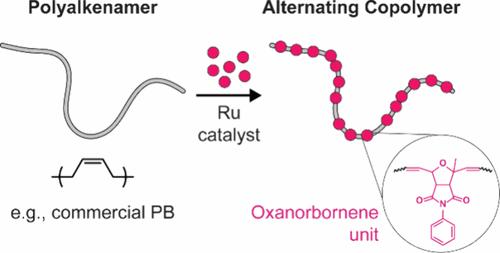用开环交叉复分解聚合调整共聚物微观结构
IF 5.2
1区 化学
Q1 POLYMER SCIENCE
引用次数: 0
摘要
研究了开环交叉复分解(RO/CM)聚合制备交联共聚物的性能。用体积较大的氧生冰片烯单体和钌基烯烃复分解催化剂处理商品聚丁二烯,在温和条件下制备了序列保真度高的交联共聚物。我们发现交替共聚物可以从多种丁二烯来源开始,包括PB,环二烯(COD)或t,t,t-1,5,9-环十二癸烯(CDT),这首次突出了该过程的动力学途径独立性。对氧化蒽单体与CDT的动力学共聚分析表明,与类似的均聚合相比,得到了更高的单体转化率,并显示了单体交替掺入的证据。这些单体的共聚也可以很好地控制不同分子量的目标。共聚物热分析显示,热行为与交替序列保真度之间存在很强的相关性,这为调整热行为提供了除成分之外的第二个杠杆。这些数据表明,通过RO/CM聚合可以获得多种聚合物微观结构,并突出了CDT在交替共聚物合成中的潜力。本文章由计算机程序翻译,如有差异,请以英文原文为准。

Tuning Copolymer Microstructure Using Ring-Opening Cross-Metathesis Polymerization
The capability of ring-opening cross-metathesis (RO/CM) polymerization to produce alternating copolymers was studied. By treating commercial polybutadiene (PB) with bulky oxanorbornene monomers and Ru-based olefin metathesis catalysts, alternating copolymers were produced under mild conditions with high sequence fidelities. We found that alternating copolymers could be produced starting from a variety of butadiene sources including PB, cyclooctadiene (COD), or t,t,t-1,5,9-cyclododecatriene (CDT), highlighting for the first time the kinetic pathway independence of this process. Kinetic copolymerization analysis of an oxanorbonene monomer with CDT revealed that much higher monomer conversions were obtained compared with the analogous homopolymerizations and showed evidence of alternating monomer incorporation. Copolymerization of these monomers also enabled good control when targeting different molecular weights. Copolymer thermal analysis revealed a strong correlation between thermal behavior and alternating sequence fidelity, providing a second lever beyond composition to tune thermal behavior. These data demonstrate that a broad variety of polymer microstructures can be accessed via RO/CM polymerization and highlight the potential of CDT in alternating copolymer synthesis.
求助全文
通过发布文献求助,成功后即可免费获取论文全文。
去求助
来源期刊

Macromolecules
工程技术-高分子科学
CiteScore
9.30
自引率
16.40%
发文量
942
审稿时长
2 months
期刊介绍:
Macromolecules publishes original, fundamental, and impactful research on all aspects of polymer science. Topics of interest include synthesis (e.g., controlled polymerizations, polymerization catalysis, post polymerization modification, new monomer structures and polymer architectures, and polymerization mechanisms/kinetics analysis); phase behavior, thermodynamics, dynamic, and ordering/disordering phenomena (e.g., self-assembly, gelation, crystallization, solution/melt/solid-state characteristics); structure and properties (e.g., mechanical and rheological properties, surface/interfacial characteristics, electronic and transport properties); new state of the art characterization (e.g., spectroscopy, scattering, microscopy, rheology), simulation (e.g., Monte Carlo, molecular dynamics, multi-scale/coarse-grained modeling), and theoretical methods. Renewable/sustainable polymers, polymer networks, responsive polymers, electro-, magneto- and opto-active macromolecules, inorganic polymers, charge-transporting polymers (ion-containing, semiconducting, and conducting), nanostructured polymers, and polymer composites are also of interest. Typical papers published in Macromolecules showcase important and innovative concepts, experimental methods/observations, and theoretical/computational approaches that demonstrate a fundamental advance in the understanding of polymers.
 求助内容:
求助内容: 应助结果提醒方式:
应助结果提醒方式:


